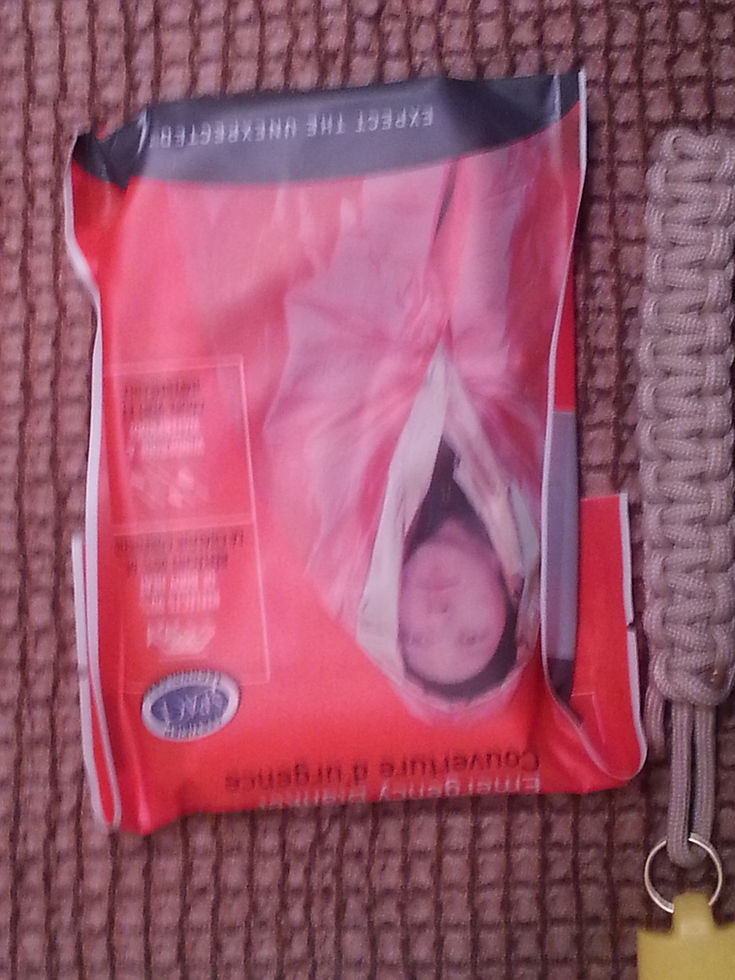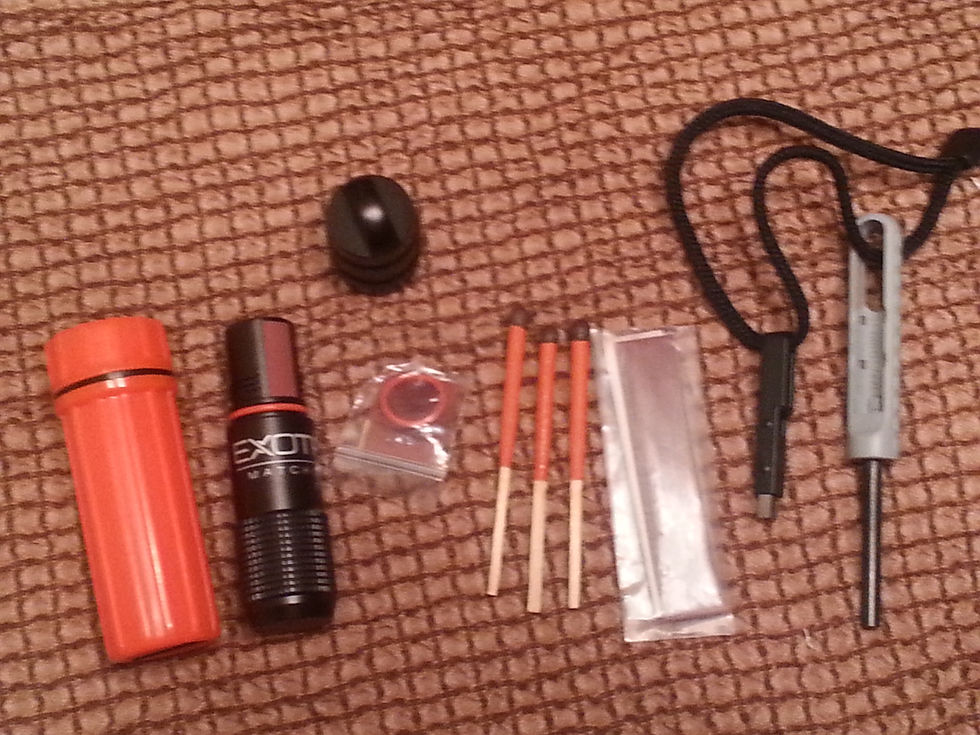Survival Kit-What should be in it?
- Rico of RATH-Defense
- Mar 14, 2019
- 5 min read

When making a kit you should try to cover as many of the “Priorities of Survival”. If you can cover six of eight you will have a complete kit; at least gear wise. Make sure you get quality items and learn how to use them properly. Try them out, do not just read instructions, books, or packaging and think that you have learned how to use the item. For example, take your tools for fire making out and make a fire.
Seven Priorities of Survival:
Will to Live [WTL]
Tools*
Shelter*
Fire*
Water*
Signal/Communication*
Medical*
Sleep
Tools: Your primary tool should be a quality Fixed Blade Knife [Full tang]; examples: Tom Brown Tracker [T1 or T2], Brothers of Bushcraft Fieldcraft, Ontario Blackbird, Ka-Bar, Becker BK2, Mora, or similar quality knife [even a machete can fill this need]. The knife does not need to be gigantic. The reason I list this at #2 is because you can make some of the other priorities with a quality knife. Also, make sure you get a model without serrations on the blade edge as this is your carving area; the back is okay for serrations. You may also want to get a multi-tool and/or a folding knife; none of these can replace the versatility of the Fixed Blade Knife though. With a Fixed Blade, you can use it to carve traps and other tools, as well as slit wood for making a fire. I personally like the Tracker T1, but some people do not like the knife; I also use a Fieldcraft when a smaller knife is needed [ie less space and not pack/ruck]. I’ve used the T1 during four survival schools and was able to use it for all tasks. The important thing is to get a knife that you can work with and you feel confident in using it; so if you get one use it and get familiar with how it handles. [The T1 has become my Ruck knife and the Fieldcraft is on my OWB EDC and Battle Belt]. See our videos on EDC and Battle Belts.
Shelter*: Clothing is your first level of shelter. Pick poly-cotton or NYCO [nylon-cotton], as these materials dry quicker than 100% cotton and will have less chance to cause hypothermia when wet. Look for military type field uniforms [IE: BDU's, DCU's, MultiCam, MARPAT, etc]. Another good clothing option is wool. Wool is able to still keep you warm even when wet. Look for wool clothing at hunting, camping, hiking stores that sell wool field clothing. For additional shelter, look get a Poncho/Tarp or Tent/Bivi [get military grade ponchos, not the cheap camping store discount ones]. For a small kit or pocket kit get an Emergency Blanket. You may also want a wool blanket, Poncho Liner, or sleeping bag if you are able to carry one. Also, you should include cordage, such as 550 Cord [para-cord]. The cordage will allow you to secure a shelter easier than making cordage in the field. The 550 Cord can be used to tie a poncho or tarp up as a field expedient tarp tent or even a hammock with some models.

Fire*: You want at least three ways to make a fire. A Ferro Rod, lighter, and storm matches. A Ferro rod is one of the most reliable fire-starting options, especially since it is a gross motor skill and can be worked even when hypothermia is setting in. For lighters, I like Zippo and ExoTac Titian, but Bic or butane work too; just remember these don't work above 8000ft, whereas Zippo's usually can. You may want to also carry a fire starter tinder, such as cotton balls in petroleum jelly, dryer lint in petroleum jelly, or even commercial starters like “Wetfire” or “Zippo” brand tinder sticks.

Water*: You should have a metal pot and/or metal bottle [w/o plastic on them] that you can boil water in at a minimum. If you choose the bottle, this will allow you to bring water to start with. You may want to carry plastic canteens/Nalgene bottles or hydration bladders to supplement. It is always best to carry water with you when you start a trip out into the outdoors. Also, look at getting Iodine or Chlorine purification tablets. I have Chlorine in my kit as I have family members who are allergic to iodine; if you or someone in your group has shellfish/iodine allergies or thyroid issues use the Chlorine ones. If you are carrying a larger pack, you may want to also carry a Steripen and/or a pump filter.
Signal/Communication*: You will want to have some kind of signaling device to communicate that you need help or to signal your location to a Search and Rescue Team. Get a Signal Mirror and a Whistle, when using either you do each three times [three shines or three blows at a time]. You could even do them in conjunction, shine and blow the whistle each time you shine.
Medical*: Have a quality first-aid kit. I have a pieced together kit based on military deployment kits, you can buy pre-made kits, and the best for an individual is an "IFAK" [Individual First-Aid Kit - look at military gear sites for these] and then add some band-aids and antibiotic ointment and maybe an Adventure Medical Kits pill kit for minor issues. The IFAK contains the items you will most likely need in a larger medical emergency such as a gunshot wound, impalement from a branch if you fall, stab wound, or other major hemorrhaging issues. See our article on the IFAK- Click Here
Pouches/Containers: I like to use small MOLLE/PALS pouches with internal slots/pockets for kits, these allow you to put everything in one pocket or attach it to a vest, belt, or pack.

In closing, Priorities Number 1) WTL and 8) Sleep, you have to do for yourself. You have to set up the WTL in your own mind, and everybody’s reason to live is different. In my own personal survival situations, the thought of not being there for my family is what kept me going. To some people, it is their faith, but you need to evaluate your life and figure out why you want to live and make it through a survival situation if you end up in one. It is best to establish your WTL before you head out to the wilderness for an outing. Sleep is also important in a survival situation if you do not get any sleep you will have trouble thinking straight and focusing on even simple tasks. If you do not sleep, this may also affect your WTL, as you may lose focus on why you want to live and survive the situation you may find yourself in.
We have SERE [Survive-Evade-Resist-Escape] & Basic Survival courses available upon request. Contact Raven One-Five for SERE & RATH-Defense for Basic Survival.
Copyright RATH-Defense, LLC 2019




































![Bug-In or Bug-Out? [Part 2]](https://static.wixstatic.com/media/f3612c_6a66d07503b24515878989a93ba35807~mv2.jpg/v1/fill/w_186,h_250,fp_0.50_0.50,q_30,blur_30,enc_avif,quality_auto/f3612c_6a66d07503b24515878989a93ba35807~mv2.webp)
![Bug-In or Bug-Out? [Part 2]](https://static.wixstatic.com/media/f3612c_6a66d07503b24515878989a93ba35807~mv2.jpg/v1/fill/w_38,h_51,fp_0.50_0.50,q_90,enc_avif,quality_auto/f3612c_6a66d07503b24515878989a93ba35807~mv2.webp)
![Bug-In or Bug-Out? [Part 1]](https://static.wixstatic.com/media/f3612c_97e6cee13d634ef28062450c4c46e7ee~mv2.jpg/v1/fill/w_186,h_250,fp_0.50_0.50,q_30,blur_30,enc_avif,quality_auto/f3612c_97e6cee13d634ef28062450c4c46e7ee~mv2.webp)
![Bug-In or Bug-Out? [Part 1]](https://static.wixstatic.com/media/f3612c_97e6cee13d634ef28062450c4c46e7ee~mv2.jpg/v1/fill/w_38,h_51,fp_0.50_0.50,q_90,enc_avif,quality_auto/f3612c_97e6cee13d634ef28062450c4c46e7ee~mv2.webp)











Comments